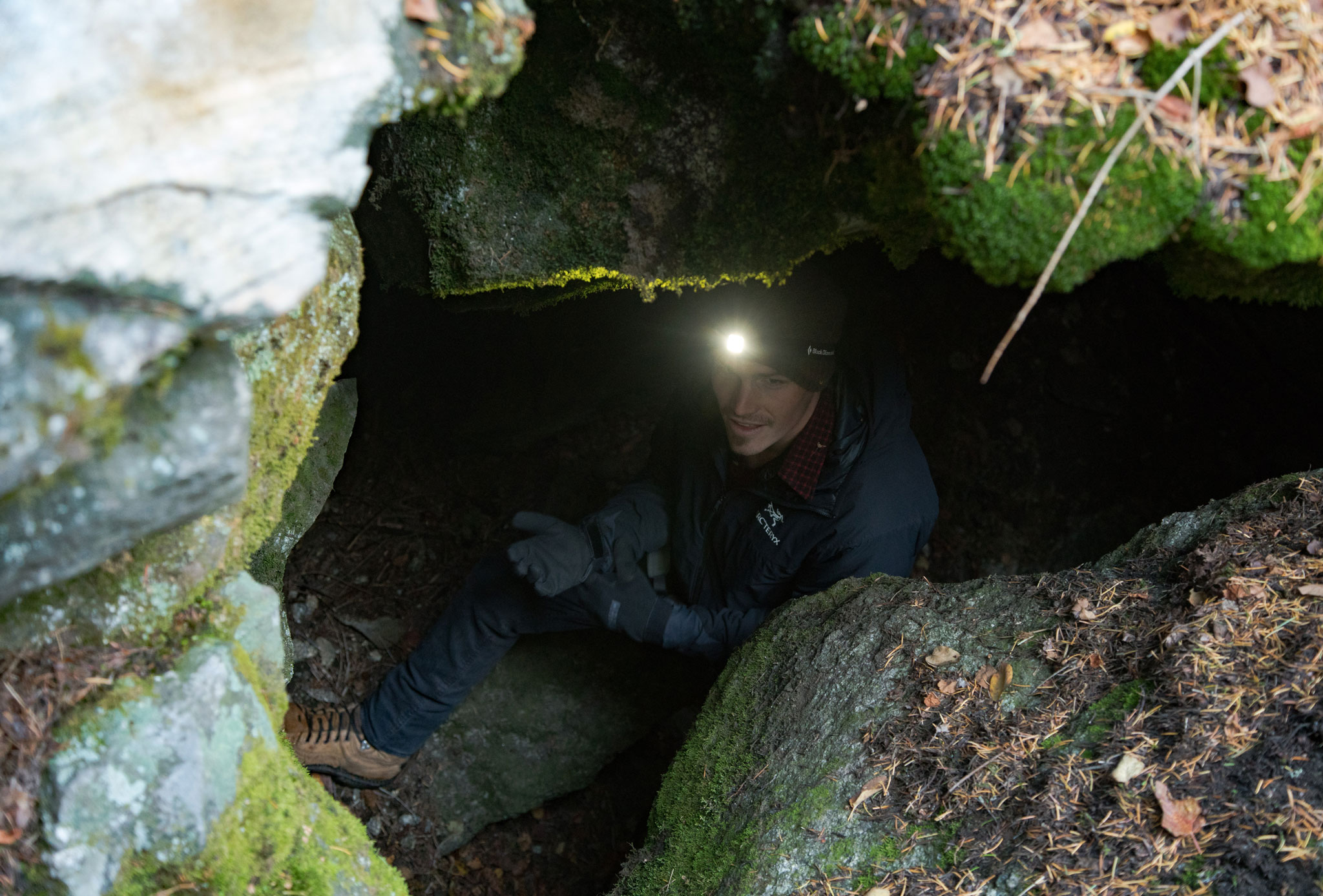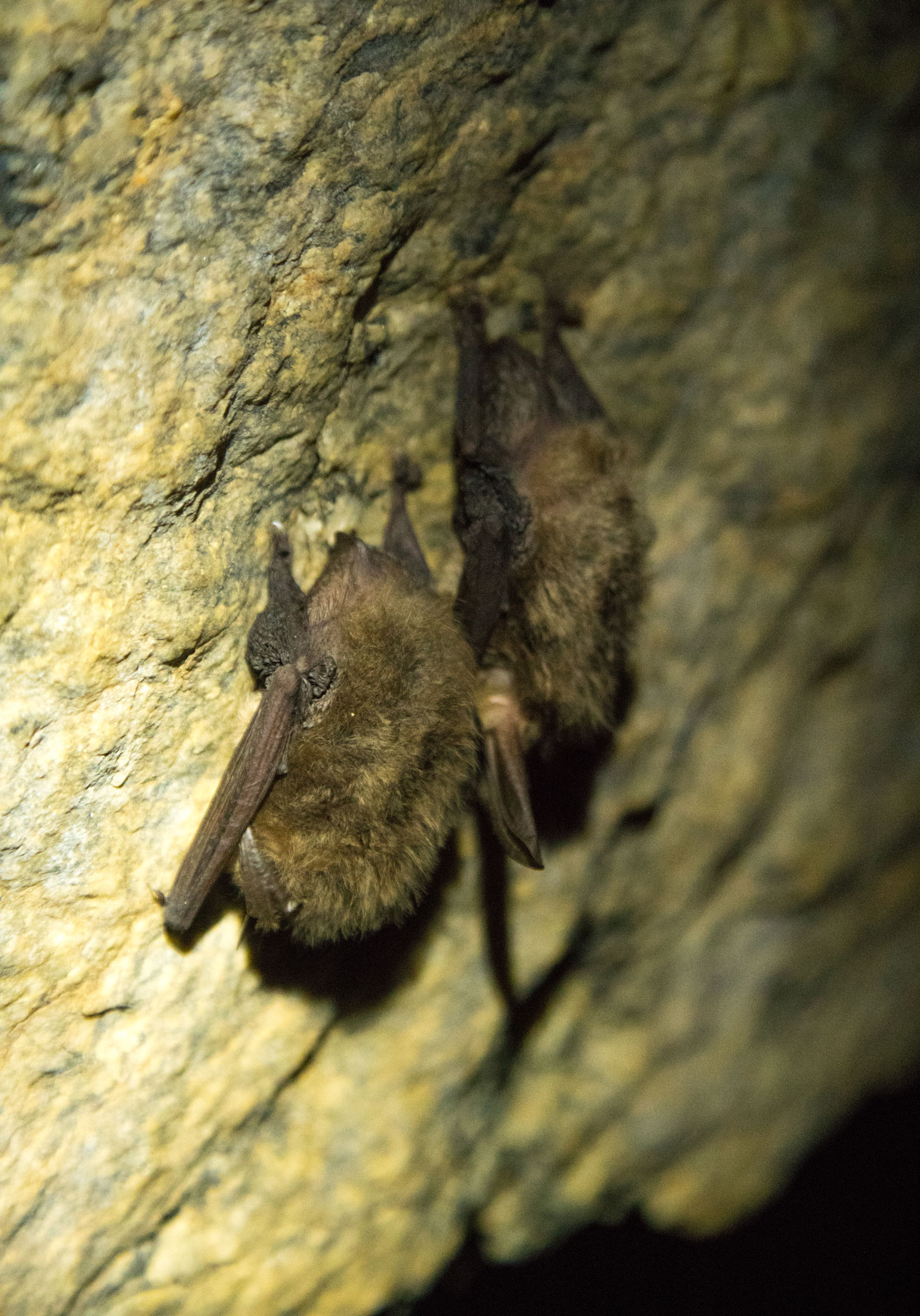Between several large, trucksized boulders was a hole that led down below the surface. After a quick squeeze through, the light disappeared along with the fresh air. Click, click, click, click. Our headlamps turned on and illuminated the stagnant air not far below the entrance of this remote cave our team of four adventurers just discovered.

We stood there, blinking and allowing our eyes to adjust to the extremes of going from surface-of-the-sun brightness to total darkness in a millisecond. We could see only about 30 feet ahead. The walls glistened and shimmered from water seeping through cracks above and from crystals embedded in the granite.
After many months of exhaustive effort to find and explore this cave, and with our adrenaline pumping, we grabbed any gear we thought we could possibly need —harnesses, ropes and gloves — and began our descent.
It smelled musty, oddly like a wet cat. We joked about how horrible it would be if a less-than-friendly 200-pound kitty actually lived in here. Darkness enveloped us, but our headlamps pierced the blackness like a lighthouse on a dark coastline warning of potential dangers nearby.
Story continues after a quick message from our sponsor below.
We carefully picked our way down a steep dirt and rock ramp. No big cats so far, although seeing one would not be in the realm of impossibilities when wandering around the mountains of North Idaho. We kept our heads on a swivel and continually looked around as the headlamps lit up only a spot directly in front of us. Several times someone let out a quick “Whoa!” followed by a jolt sideways as he realized he nearly grazed his helmet against a slumbering bat.
This was spelunking.
» SECRET CAVE
From the earliest known records of human existence, our species has been filled with wonder and amazement at some of our planet’s most mysterious underground features. That wonderment has persisted, turning cave exploration — also called spelunking — into a hobby for modern-day adventurers.
We have used caves for everything from art to shelter to pure adventure and fun.

There is one such place in the mountains of North Idaho. One of the few remaining spots here where you’ll find underground adventure and mystery, a seemingly endless system of unexplored frontier.
If you look across the Rathdrum Prairie to the north, three prominent peaks can be seen. Rathdrum Mountain on the right, Mt. Spokane to the left and one other in the middle. Upon closer inspection, it becomes clear this third feature is not a peak but a ridge. Aptly named Ragged Ridge, its rugged cliff bands and buttresses jut out from exceedingly steep flanks peppered with ghostly-looking dead trees, making exploration of its remote faces difficult. A few old-timers secretly swear there are caves on that distant ridge.

Only a single paragraph, buried deep in a geologic study from the early 90s and hastily scanned onto the World Wide Web described how a team of scientists did, in fact, discover a series of caves on that mysterious ridgeline. They stated that due to a lack of gear, they did not venture inside any of them.
That was it! That was the proof we needed.
» GETTING THERE
A confusing maze of overgrown dirt roads, private property and rugged terrain lay between the nearest paved road and the ridge. It turns out access is best made from the northeast of Twin Lakes. After about 45 minutes of bouncing down another maze of old logging roads and one final stretch that would give any vehicle a beautiful North Idaho pinstriping job, the road ends.
At this point, the topographic maps came out. The combined experiences of our group made for easy deciphering of the different lines and shading depicting the mountain we were about to climb. Jason Wilmoth and I were already familiar with the area having searched it several times in recent years.
From our current position, we made our way up to the top of the ridgeline, dead reckoning our way through the forest, occasionally picking up a game trail. Once on top, we followed an old trail down along the center of the ridge. The trail cuts through a mixture of dense forest, grassy meadows, thick buck brush and exposed rock faces. After walking roughly a mile and a half, we determined we were in the vicinity of the caves. We left the relative ease of the trail and began bushwhacking our way several hundred feet down the extremely steep western side of the ridge.

Jason and I shouted back and forth to each other with estimated relative positions compared to the map. Chris Doll and Jeff Ault were fanned out on the hillside looking for anything that resembled a cave. Constantly reconfirming positions with landmarks and isobars on the map to the approximate known location of the caves, our team finally stumbled across a seemingly unobtrusive boulder pile in the middle of a particularly nasty patch of buck brush and pine trees.
“Hey! I think we finally found it!” I yelled.
» EUREKA!
Darkness isn’t darkness until one experiences a cave. It is an overpowering experience. A sensory overload of epic proportions. The human body compensates for the lack of certain senses by amplifying others. In the darkness, the absence of all light is almost unnerving. The thought of how our earliest ancestors coped with these same feelings, and with the lack of modern technology, while pushing headlong into caves is impressive, to say the least.
We made our way farther down into the cave in awe of whatever we aimed our lights at. The first ramp descended about 200 feet in length and dropped at least 75 feet below the surface. There was enough room to stand up in most spots, but there were a few large boulders hanging down from the ceiling we had to duck to clear. The cave was an odd combination of chilly but extremely humid. It felt like it was in the 40s, yet we were all sweating profusely.

The occasional bat slept the day away, waiting for the sun to go down. How they know when it is dark outside when there is no light for reference in the cave is one of life’s great mysteries. The grey and yellow mineral-stained granite walls that make up the cave were mostly straight-sided and angular. It looked as if one giant plate was ripped away from the other, which is, in fact, what happened.
The old geological study we referenced was written based on ancient landslides in the area. These caves are the result of exactly that: ancient subterranean landslides. As the team moved, incredible veins of minerals embedded in the rock shimmered and glowed in the bright white lights emitted from our lights.
» MYSTERIOUS FIND
Finally, we reached the edge of an abyss and an open chamber deep inside the cave. Jason peered over the edge and yelled “Hellooo” into the blackness below. Even the powerful lights could not penetrate far enough into the darkness to see the bottom.
Our excitement boiled over when we realized we could use all of our climbing gear we lugged down inside this mysterious hole in the ground. After Chris and I built an anchor and threw down rope into the darkness, we roshamboed for who would be the first to venture into the void.

Chris won. He tied in to the rope and began to lower himself down the nearly vertical wall into what was truly the unknown. Suddenly, his world became very small. He was alone. His breath hung in the air in front of his face; his headlamp partially blinded him as the light reflected off his breath in the eerily still cave. The walls were close and damp.
We watched from above as his light slowly faded away. The only confirmation everything was all right came as we called out to him and heard his responses echoe up and down the chasm.
“You ok?” Jeff yelled nervously down toward the small white speck of light below.
“Yeah, it’s incredible down here!” Chris called back.
As Chris neared the end of his 50-meter rope, the bottom appeared. The cave had constricted a bit and it was a bit of a squeeze near the landing zone. Unlike the muddy ramp up top, the bottom of the cave was filled with gravel from thousands of years of erosion taking its toll on the rocks that make up this incredible place.

This was the quintessential age-old adventure.
» LIGHT OF DAY
We spent the better part of six hours exploring the inner workings of the cave. There were several intriguing-looking passages left to see, but the day was quickly fading and we decided to make our way back to the surface.
In the end, we had descended at least 175 feet underground. Ascending the vertical line up from the abyss took a significant amount of work and took the better part of two hours. As we climbed back out of the ground, we squinted and blinked in the blinding daylight and took long, deep breaths of the fresh air.

“Boy, you don’t realize how much you take fresh air for granted until you breathe stagnant cave air for a day,” Jeff says.
“Yeah, but now we get to breathe thin high-altitude air,” Jason said, jokingly.
We slowly trudged our way back up and over the ridge and down to the truck. Our bodies were exhausted. But our minds were running at the speed of light with thoughts of the day’s accomplishments and how we measured up to generations of explorers before us, embarking a grand adventure into the unknown, in search of the unknown. This was the quintessential age-old adventure.
This was spelunking. N
Story and Photography By Chris Celentano
As Featured In: 2018 Summer/Fall CDA Edition





10 Comments
what are the coordinates?
I do not have coordinates available. The caves are marked on local topo maps on the west side of Ragged Ridge.
Hey, I and my friends love exploring, we live in the area and we would much appreciate it if you pointed us in the right direction of where to find it.
Two of the caves are on the west side of Ragged Ridge about 150 yards down from the ridge trail. The best access is from Twin Lakes. Pick up a topo map of the area and it should show the caves and their locations. Don’t forget to pick up an Inland Paper Pass as well since the land is owned by Inland Paper.
Chris – the only ‘ragged’ anything I can find is ragged mountain, on the washington side. is this accurate?
nevermind, I found it, thanks.
We spent many weekends when we were between 14 and 18 riding motorcycles up and down Ragged Ridge. We too found and explored all three caves. We were always familiar with the south cave, but we spent days and days searching for the two west-side caves. We only had some homemade rope and a couple of flashlights, yet we were lucky(stupid) enough to reach most depths. Our greatest find in the larger west side near the deepest cavern. I found a large albino cricket with white eyes and antenna three times its body length. Later in college at EWU, I influenced my speleology class to travel up and map that larger west-side cave. So, somewhere at Eastern Washington University there is a recorded mapping. I’ll help you locate the southern cave if I can go 🙂
That’s awesome! I’m sure there are all kinds of unique creatures down there. I would love to see that map! We found the southern cave on our first trip up there, but inland paper jammed a massive log into its entrance. I suspect that cave is pretty large inside too.
Isobar?
Perhaps “contour line” is the correct descriptor.
Near Moscow Idaho I drilled through a cavern drilling my well. I believe it may be large as the air never stops blowing from it. I had to seal up my well head and valve it to only allow the warm air to heat my pump house. Ever since I have been looking for an entrance on my ranch. Wondering if any cavers may have advice to help in my search?